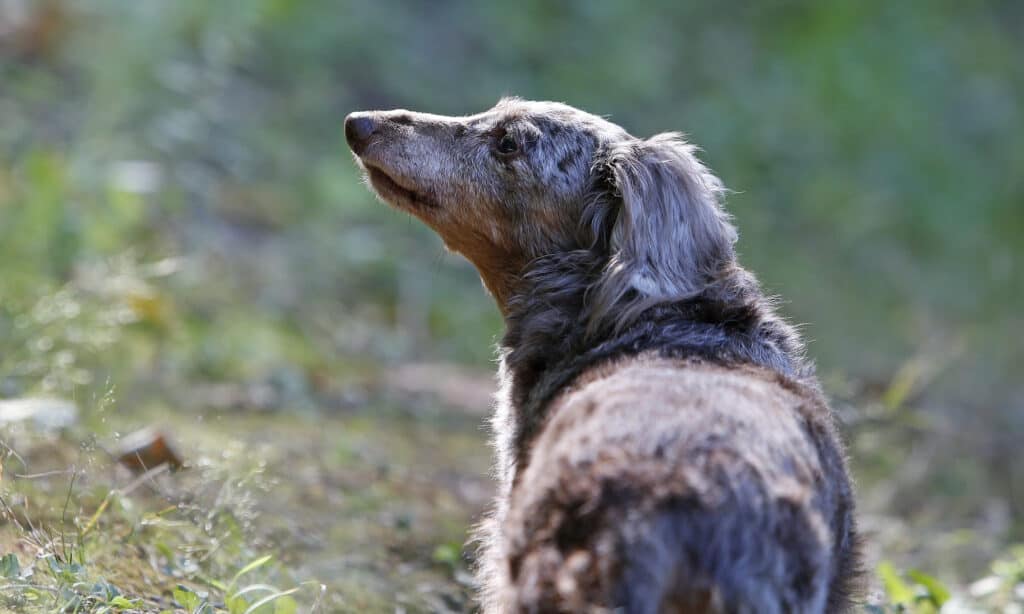Welcome to the ultimate breed guide for Blue Dapple Dachshunds! If you’re considering adding one of these unique and beautiful pups to your family, you’ve come to the right place. In this guide, we’ll explore everything you need to know about this fascinating breed, from their history and personality traits to their grooming needs and health concerns.

Blue Dapple Dachshunds are a relatively rare variety of the already beloved Dachshund breed. Known for their striking blue and white dappled coat, these dogs are sure to turn heads wherever they go. But there’s much more to these pups than just their stunning looks.
Dachshunds have a long and interesting history that dates back to the 15th century in Germany. Originally bred for hunting badgers and other small game, these dogs have since become popular family pets due to their friendly and playful personalities. Blue Dapple Dachshunds are no exception! They make loyal and loving companions for those lucky enough to share their home with them.
Despite their small size, Dachshunds are known for their big personalities. These dogs are often described as spunky, curious, and even a bit stubborn at times. They love to be around their people and will follow them around the house, always eager to be part of the action.
In this guide, we’ll delve into all these topics and more, so you can make an informed decision about whether a Blue Dapple Dachshund is the right breed for you. So sit back, relax, and get ready to learn everything there is to know about these amazing dogs!

History of the Blue Dapple Dachshund
The dapple Dachshund is a unique variety of the beloved Dachshund breed. To understand the history of the Dachshund, it’s important to first understand the history of the Dachshund breed as a whole.
The Dachshund breed originated in Germany in the 15th century. These dogs were originally bred to hunt badgers and other small game. Their long, low-slung bodies and strong sense of smell made them excellent hunters, especially in underground burrows.
Over time, the Dachshund’s hunting skills became less important as their popularity as companion dogs grew. By the 19th century, Dachshunds were a beloved family pet in Germany, and they soon gained popularity around the world.
The Blue Dapple Dachshund is a relatively new variation of the breed. The dapple pattern itself is caused by a genetic mutation that results in lighter-colored spots on a darker base coat. The blue dapple variation is characterized by a blue-gray base coat with lighter blue-gray spots.
While the exact origins of the blue dapple variation are unknown, it’s believed that the mutation occurred naturally within the Dachshund gene pool. Blue Dapple Dachshunds were likely first bred in the United States. They quickly gained popularity due to their unique and striking appearance.
Today, Blue Dapple Dachshunds are a rare but beloved variety of the Dachshund breed. While they may have started out as hunting dogs, they have since become popular as family pets due to their friendly personalities and unique appearance. Whether you’re a long-time Dachshund lover or just discovering the breed for the first time, the Blue Dapple Dachshund is sure to capture your heart.
Coat and Coloration of Blue Dapple Dachshunds
The coat of a Blue Dapple Dachshund is one of their most distinctive features. These dogs have a short, smooth coat that is characterized by a blue-gray base color with lighter blue-gray spots or dappling.
The dappling pattern itself is caused by a genetic mutation that affects the distribution of pigment in the dog’s coat. This results in lighter-colored spots on a darker base coat, giving the Blue Dapple Dachshund their unique and eye-catching appearance.
It’s worth noting that while the blue dapple variation is striking, it’s not recognized as an official color by all breed registries. Some registries consider blue dapple Dachshunds to be a variation of the black and tan or chocolate and tan coloration. Others recognize it as a separate color variation.
In addition to their distinctive coat coloration, Blue Dapple Dachshunds may also have other markings, such as tan points on their legs, chest, and face. Some Blue Dapple Dachshunds may also have a white blaze on their chest or white markings on their toes.
When it comes to grooming, Blue Dapple Dachshunds are relatively low maintenance. Their short, smooth coat doesn’t require frequent brushing or trimming, although regular baths and nail trims are still important. It’s also worth noting that Dachshunds are prone to shedding. Regular vacuuming may be necessary to keep your home clean.

Blue Dapple Dachshund Temperament
The Dapple Dachshund has a friendly, spunky, and curious personality that is sure to capture your heart. While they were originally bred as hunting dogs, Dapple Dachshunds have since become popular family pets due to their affectionate and playful nature.
One of the defining characteristics of the Blue Dapple Dachshund is their loyalty to their owners. These dogs love to be around their people and will follow them around the house, always eager to be part of the action. They’re known for being quite clingy, but in a good way! They just want to be near their humans as much as possible!
Despite their small size, Dapple Dachshunds have big personalities. They’re known for being spunky and curious, and they’re always up for an adventure. They’re also quite intelligent, which can sometimes translate to stubbornness. However, with consistent training and positive reinforcement, Blue Dapple Dachshunds can learn to be well-behaved and obedient companions.
Like all dogs, the temperament of a Dapple Dachshund can vary based on their individual personality and experiences. However, in general, these dogs are known for being friendly and outgoing with people of all ages, including children. They can also get along well with other pets, although socialization and training are important to ensure they play nicely with others.
It’s important to note that Dachshunds can be prone to separation anxiety if left alone for long periods of time. This is why they’re often recommended for families or individuals who can spend a lot of time with them. They’re also known for being vocal – they’ll bark at anything from strangers to leaves blowing in the wind!
Should You Choose To Rescue or Purchase a Blue Dapple Dachsund?
Deciding whether to rescue or purchase a Blue Dapple Dachshund is an important decision that requires careful consideration of your lifestyle and preferences. There are pros and cons to both options, and it’s essential to weigh them carefully before making a choice.
Rescuing a Blue Dapple Dachshund from a shelter or rescue organization can be an excellent choice for people who want to provide a second chance to a dog in need. Shelters often have Blue Dapple Dachshunds available for adoption, and you’ll be giving a dog a loving home while freeing up space for more dogs in need.
However, rescue dogs may come with their own set of challenges, such as unknown behavioral or health issues due to their previous experiences. It is important to work with a reputable shelter or rescue organization that can provide you with the necessary information about the dog’s background.
Purchasing a Blue Dapple Dachshund from a breeder can be a great option for those who prefer a purebred dog with a predictable temperament and appearance. By purchasing from a reputable breeder, you can ensure that the dog has been raised in a healthy and safe environment, and has been screened for any genetic health problems.
However, buying from a breeder can be more expensive than adopting from a shelter or rescue organization. It is also essential to be careful when selecting a breeder, ensuring that they prioritize the health and well-being of their dogs.
Ultimately, the choice to rescue or purchase a Blue Dapple Dachshund depends on individual circumstances and preferences. While adopting a rescue dog can be a rewarding experience, purchasing a dog from a reputable breeder can provide assurance about the dog’s health and temperament. Whatever choice you make, be sure to choose a dog that fits your lifestyle and personality.

What Should You Look For if Purchasing a Dapple Dachshund?
When you’re ready to purchase a Blue Dapple Dachshund from a breeder, it’s essential to do your homework and find a reputable breeder who cares about the health and well-being of their dogs. Here are some tips on what to look for when selecting a breeder:
Firstly, it’s important to choose a breeder with a good reputation. To find one, check online reviews and ask friends for recommendations. A trustworthy breeder should be open and transparent, answering all your questions and providing you with necessary information on their breeding practices and the health of their dogs.
Secondly, ensure the breeder conducts health checks on their dogs. Blue Dapple Dachshunds are susceptible to some health problems like eye issues and back problems. A responsible breeder should screen their dogs for these health concerns and should have medical records of all their dogs available for your perusal.
It’s also crucial to meet the breeder in person and visit their breeding facilities. This will allow you to observe how the dogs are raised and interact with each other and their human caregivers. Furthermore, ask to meet the puppy’s parents to get an idea of their temperament and appearance.
A good breeder should also offer information on the puppy’s training and socialization, and they should be willing to answer all your questions about caring for your new pet. They should also provide you with necessary documentation of the puppy’s health, like vaccination records and health test results.
Lastly, you should be prepared to pay a higher price for a Blue Dapple Dachshund from a reputable breeder. Although cheaper puppies are tempting, choosing a reliable breeder who raises healthy, well-socialized puppies is worth the extra cost in the long run.

How Much Does a Blue Dapple Dachshund Cost?
The cost of a Dapple Dachshund can vary depending on several factors, including the breeder, location, and demand for the breed. On average, you can expect to pay between $1,000 and $3,000 for a Blue Dapple Dachshund from a reputable breeder.
It’s important to remember that the initial cost of a puppy is just a small part of the overall cost of owning a dog. There are many ongoing expenses to consider, including food, veterinary care, grooming, and training. It’s important to budget accordingly and be prepared for the ongoing costs of pet ownership.
It’s also worth noting that while you may be tempted to choose a cheaper option, such as purchasing from a backyard breeder or pet store, this can come with risks. These sources may not prioritize the health and well-being of their dogs, and you may end up with a puppy with health or behavioral issues.
Ultimately, the cost of a Blue Dachshund is just one factor to consider when deciding whether to purchase one. It’s important to choose a reputable breeder who prioritizes the health and well-being of their dogs, regardless of the cost. By doing your research and choosing a responsible breeder, you’ll be setting yourself up for a happy and healthy relationship with your new furry friend.
Are Dapple Dachshunds Healthy?
Blue Dapple Dachshunds are generally healthy dogs, but like all breeds, they can be prone to certain health issues. Some of the most common health concerns in Blue Dapple Dachshunds include back problems, eye issues, and hip dysplasia.
Back problems are particularly common in Dachshunds due to their long, low-slung bodies. Intervertebral disc disease (IVDD) is a condition in which the discs between the vertebrae in the spine degenerate and can lead to pain, paralysis, and even death. It’s important to work with a reputable breeder who screens their dogs for IVDD and to take steps to prevent back problems, such as avoiding excessive jumping and providing proper support when carrying your dog.
Eye issues can also be a concern in Blue Dapple Dachshunds, particularly progressive retinal atrophy (PRA). This is a genetic condition that causes the retina to degenerate over time, eventually leading to blindness. Reputable breeders should screen their dogs for PRA and should be able to provide you with documentation of their health testing.
Hip dysplasia is a condition in which the hip joint doesn’t develop properly, leading to arthritis and pain. While it’s more common in larger breeds, it can occur in Dachshunds as well. Reputable breeders should screen their dogs for hip dysplasia and should be able to provide you with documentation of their health testing.

What is the Lifespan of a Blue Dapple Dachshund?
The lifespan of Blue Dapple Dachshunds can vary depending on several factors, including genetics, diet, exercise, and overall health. On average, dachshunds have a lifespan of around 12-16 years.
It’s important to work with a reputable breeder who prioritizes the health and well-being of their dogs to ensure that your dachshund has the best chance for a long and healthy life. This includes screening for common health issues such as back problems, eye issues, and hip dysplasia, as well as providing proper nutrition, exercise, and veterinary care.
In addition to genetics and health, lifestyle factors can also impact a dachshund’s lifespan. Providing regular exercise and mental stimulation, as well as keeping up with preventative healthcare measures such as vaccinations and routine check-ups, can all contribute to a longer and healthier life for your dog.
Nutrition for Blue Dapple Dachshunds
Good nutrition is essential for keeping Blue Dapple Dachshunds healthy and happy. To achieve this, it’s important to provide them with a balanced diet that includes fresh, whole foods such as meat, vegetables, and fruits.
A fresh food diet can provide many benefits, such as improved digestion, increased energy, and overall better health. It’s a great way to ensure that your dog gets all the nutrients they need without resorting to processed foods or dog kibble, which can be high in carbohydrates and sugars that lead to weight gain and health problems.
Feeding your Blue Dapple Dachshund a fresh food diet can also help prevent certain health issues such as obesity, diabetes, and skin problems. Whole foods contain important vitamins and minerals that can support your dog’s immune system, promote dental health, and give them a shinier, healthier coat.
When switching to a fresh food diet, it’s important to work with your veterinarian to create a balanced meal plan tailored to your dog’s specific nutritional needs. Your vet can provide guidance on portion sizes, protein sources, and other dietary considerations.

Exercise and Physical Activity for Blue Dapple Dachshunds
Exercise and physical activity are important for the health and well-being of Blue Dapple Dachshunds. Regular exercise can help keep them at a healthy weight, reduce the risk of certain health issues, and improve their overall quality of life.
Blue Dapple Dachshunds are an active breed and require daily exercise to stay healthy and happy. A lack of exercise can lead to weight gain, muscle loss, and a higher risk of health problems such as joint issues and heart disease.
Some great forms of exercise for dachshunds include walking, hiking, playing fetch, and swimming. It’s important to start with shorter exercise sessions and gradually increase the intensity and duration over time to avoid injury or overexertion.
In addition to regular exercise, providing your Blue Dapple Dachshund with mental stimulation is also important. Puzzle toys, interactive games, and obedience training can all help keep your dog’s mind active and engaged.
When exercising your dachshund, it’s important to be mindful of their physical limitations. Due to their long, low-slung bodies, Dachshunds can be prone to back problems, and excessive jumping or running can put added stress on their spine. It’s important to provide proper support when carrying your dog and to avoid activities that could cause injury.
Grooming Requirements for Blue Dapple Dachshunds
Taking care of your Blue Dapple Dachshund’s grooming needs is important for their overall health and happiness. Even though they have a short coat, they still require regular grooming to keep their coat and skin healthy.
To keep their coat looking shiny and healthy, it’s recommended to brush them once a week to remove loose hair. Don’t forget to check and clean their ears to prevent infections and wax buildup. Bathing is needed every few months using a mild dog shampoo to avoid drying out their skin.
Maintaining their dental hygiene is crucial too, so be sure to brush their teeth regularly or give them dental chews and treats. By doing so, you can prevent dental issues like plaque buildup and bad breath.
Blue Dapple Dachshunds have long ears that can trap moisture and debris, making them more prone to ear infections. You should check their ears frequently and clean them with a veterinarian-recommended ear cleaning solution.
Trimming their nails is another important part of grooming your Blue Dapple Dachshund. Overgrown nails can cause discomfort and pain, so it’s important to trim them regularly. If you’re not sure how to do it, you can take them to a groomer or veterinarian for assistance.
Overall, keeping up with your Blue Dapple Dachshund’s grooming needs will help keep them healthy and comfortable. Regular grooming can prevent issues like infections, bad breath, and overgrown nails. By taking care of your furry friend’s grooming needs, you can help them stay happy and healthy for years to come.
Are Blue Dapple Dachshunds Hard to Train?
Blue Dapple Dachshunds can be somewhat challenging to train due to their independent nature and stubborn streak. They have a strong instinct to follow their nose, which can make recall and off-leash training difficult.
However, with patience, consistency, and positive reinforcement training techniques, Blue Dapple Dachshunds can be trained successfully. They respond well to rewards-based training, such as treats or praise, and can learn a wide range of commands and tricks.
It’s important to start training your Blue Dapple Dachshund early and to be consistent with your training methods. Short, frequent training sessions are typically more effective than long, infrequent sessions.
Socialization is also important for Blue Dapple Dachshunds, as they can be wary of strangers and other dogs. Early socialization can help them become more comfortable in new situations and with new people and animals.
Overall, Blue Dapple Dachshunds may require a bit more patience and effort when it comes to training, but with the right approach, they can be trained successfully. By using positive reinforcement techniques and starting early, you can help your Blue Dapple Dachshund become a well-behaved and obedient companion.

Most Common Behavior Issues of Blue Dapple Dachshunds
Blue Dapple Dachshunds are generally well-behaved and affectionate dogs, but like all breeds, they can be prone to certain behavior issues. Some of the most common behavior issues in Blue Dapple Dachshunds include separation anxiety, excessive barking, and aggression.
Separation anxiety is a condition in which a dog becomes anxious and distressed when left alone. This can lead to destructive behaviors such as chewing, digging, and barking. Blue Dapple Dachshunds are prone to separation anxiety due to their strong attachment to their owners. It’s important to gradually train your Blue Dapple Dachshund to become comfortable with being alone, starting with short periods of time and gradually increasing the duration.
Excessive barking is another common behavior issue in Blue Dapple Dachshunds. They are an alert breed and may bark at perceived threats, strangers, or other animals. While some barking is normal, excessive barking can be disruptive and annoying. It’s important to identify the trigger for the barking and to work on desensitization techniques to reduce the barking behavior.
Aggression is another potential behavior issue in Blue Dapple Dachshunds. They can be possessive of their toys, food, or space, and may show aggression towards other dogs or humans. It’s important to address aggressive behavior early on and to work with a professional trainer to correct the behavior.
Training Tips for Blue Dapple Dachshunds
Here are some training tips for Blue Dapple Dachshunds:
- Start early: Begin training your Blue Dapple Dachshund as early as possible, ideally when they are still a puppy. This will help them establish good habits and prevent the development of bad behaviors.
- Use positive reinforcement: Reward-based training techniques are typically the most effective for Blue Dapple Dachshunds. Use treats, praise, or toys to reward good behavior and ignore bad behavior.
- Be consistent: Consistency is key when it comes to training your Blue Dapple Dachshund. Use the same commands and techniques every time, and make sure everyone in the household is on the same page.
- Keep it short: Blue Dapple Dachshunds have a relatively short attention span, so keep training sessions short and frequent rather than long and infrequent.
- Use a variety of techniques: Blue Dapple Dachshunds respond well to a variety of training techniques, such as clicker training, positive reinforcement, and lure and reward training. Try different methods to find what works best for your dog.
- Socialize: Socialization is important for Blue Dapple Dachshunds to help them feel comfortable around other dogs, animals, and people. Take your dog to the dog park or on walks around your neighborhood to help them get used to new situations.
- Address bad behavior early: If you notice your Blue Dapple Dachshund exhibiting bad behavior, address it early before it becomes a habit. Work with a professional trainer or behaviorist if necessary.
By following these tips, you can help your Blue Dapple Dachshund become a well-behaved and obedient companion. Remember to be patient and consistent, and always use positive reinforcement techniques.

Conclusion
Blue Dapple Dachshunds are a unique and wonderful breed of dog. With their distinctive coat pattern, charming personality, and loyal nature, they make great companions for families and individuals alike.
As with any breed, it’s important to understand the specific needs and characteristics of Blue Dapple Dachshunds before bringing one into your home. They require regular exercise, grooming, and training, as well as a healthy diet and regular veterinary care.
While they can be challenging to train at times, with patience and positive reinforcement techniques, Blue Dapple Dachshunds can learn to become well-behaved and obedient companions. Socialization is also important for this breed to prevent issues like separation anxiety and aggression.
If you’re considering adding a Blue Dapple Dachshund to your family, be sure to do your research and find a reputable breeder or rescue organization. With proper care and attention, a Blue Dapple Dachshund can bring many years of joy and companionship to your life.
~Lindsie
